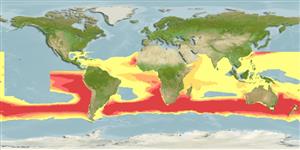Common names from other countries
>
Zeiformes (Dories) >
Oreosomatidae (Oreos) > Oreosomatinae
Etymology: Allocyttus: Greek, allos = other + Greek, kyttaros, kytos = a convex cavity.
Environment: milieu / climate zone / depth range / distribution range
पारिस्थितिकी
समुद्री बैथीपिलाजिक; औशिनोड़िरोमस (Ref. 51243); गहराई सीमा 0 - 1800 m (Ref. 50610), usually 800 - 1200 m (Ref. 6545). Deep-water; 28°N - 58°S
Eastern Atlantic: off Mauritania, Gulf of Guinea, Namibia and South Africa. Western Atlantic: off Suriname, southern Brazil and Uruguay. Western Indian Ocean: Mozambique Channel, Walters Bank. Eastern Indian Ocean: East Indian and West Australian Ridge, Australia. South Pacific: New Zealand and off Chile. Records from the North Pacific belong to Allocyttus folletti. Also Ref. 26139).
Length at first maturity / आकार / वज़न / Age
Maturity: Lm 28.0, range 23 - ? cm
Max length : 42.5 cm TL पुल्लिंग / अलिंग; (Ref. 27159); अधिकतम प्रकाशित वज़न: 2.0 kg (Ref. 27124); अधिकतम सूचित उम्र: 140 वर्षो (Ref. 39383)
पृष्ठीय रीढ़ (सम्पूर्ण) : 5 - 8; पृष्ठीय सौफट रेज़ (सम्पूर्ण) : 28 - 33; गुदा कांटा: 2 - 3; ऐनल सौफट रेज़: 26 - 31. Adults blackish black in color; prejuveniles silvery, back greenish with large grey blotches that disappears at about 12 cm (Ref. 6548).
Occurs on the continental slope (Ref. 9563), forming large shoals over rough ground near pinnacles and canyons (Ref. 6390). Juveniles are pelagic and inhabit oceanic waters in depths of less than 1000 m (Ref. 27230). They tend to be dispersed over smooth grounds (Ref. 6390). Feeds on shrimps, cephalopods, and fishes (Ref. 6548). The eggs float near the sea surface and the larvae also inhabit surface waters (Ref. 6390). Trawl catch rates for warty oreos, and for oreos in general, show no evidence of vertical migration during day or night (Ref. 27150), even though many of the planktonic species consumed by this species undergo daily migrations within the water column (Ref. 6390).
Life cycle and mating behavior
Maturities | पुनरुत्पत्ति | Spawnings | Egg(s) | Fecundities | लार्वा
Displays seasonally synchronised reproduction.
Karrer, C., 1990. Oreosomatidae. p. 637-640. In J.C. Quero, J.C. Hureau, C. Karrer, A. Post and L. Saldanha (eds.) Check-list of the fishes of the eastern tropical Atlantic (CLOFETA). JNICT, Lisbon; SEI, Paris; and UNESCO, Paris. Vol. 2. (Ref. 6545)
IUCN Red List Status (Ref. 130435)
CITES (Ref. 128078)
Not Evaluated
Threat to humans
Harmless
Human uses
मात्स्यिकी: लघु वाणिज्य
साधन
Special reports
Download XML
इंटरनेट स्रोत
Estimates based on models
Preferred temperature (Ref.
115969): 3.4 - 6.9, mean 4.9 (based on 252 cells).
Phylogenetic diversity index (Ref.
82804): PD
50 = 0.5635 [Uniqueness, from 0.5 = low to 2.0 = high].
Bayesian length-weight: a=0.01380 (0.00803 - 0.02372), b=3.05 (2.89 - 3.21), in cm Total Length, based on LWR estimates for this species & (Sub)family-body (Ref.
93245).
Trophic level (Ref.
69278): 4.2 ±0.73 se; based on food items.
लौटाव (Ref.
120179): बहुत नीचे, न्यूनतम जनसंख्या दुगनी समय अवलागत 14 महीने। (tmax=140).
Fishing Vulnerability (Ref.
59153): High to very high vulnerability (68 of 100).
